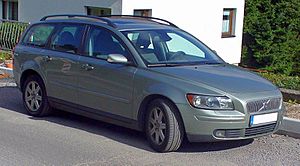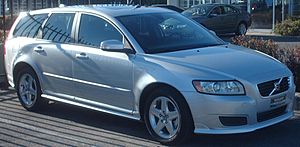Volvo V50 facts for kids
The Volvo V50 is a type of car that was made by the Swedish company Volvo. It first came out in 2004. The V50 is known as a "station wagon" or "estate" car. This means it has a longer back area for more storage space, like a bigger trunk.
The V50 was built on the same platform as the second version of the Volvo S40 sedan. It took the place of an older car called the Volvo V40, which was also a station wagon version of the first S40. After many years, in 2012, the V50 was replaced by a new car. Interestingly, this new car was also called the V40, even though it was a completely different model.
What Powers the V50?
Cars need engines to move, and the Volvo V50 had many different types of engines. These engines could use either gasoline (petrol) or diesel fuel. Each engine offered a different amount of power, which affects how fast the car can go and how much fuel it uses.
Here are some of the engine types that were available for the Volvo V50:
- Gasoline Engines:
- 1.6 engine: This was a good choice for everyday driving.
- 1.8 engine: A bit more powerful than the 1.6.
- 2.0 engine: Offered a good balance of power and fuel use.
- 2.4 and 2.4i engines: These were stronger engines, giving the car more speed.
- T5 engine: This was the most powerful gasoline engine available. It made the V50 quite fast and sporty!
- Diesel Engines:
- 1.6 D and D2 engines: These were designed to be very good on fuel.
- 2.0 D engine: A popular diesel option with a good amount of power.
- D3, D4, and D5 engines: These were more powerful diesel engines, offering a strong and smooth ride.
Each of these engines helped the Volvo V50 be a reliable and comfortable car for families and individuals.
Images for kids






